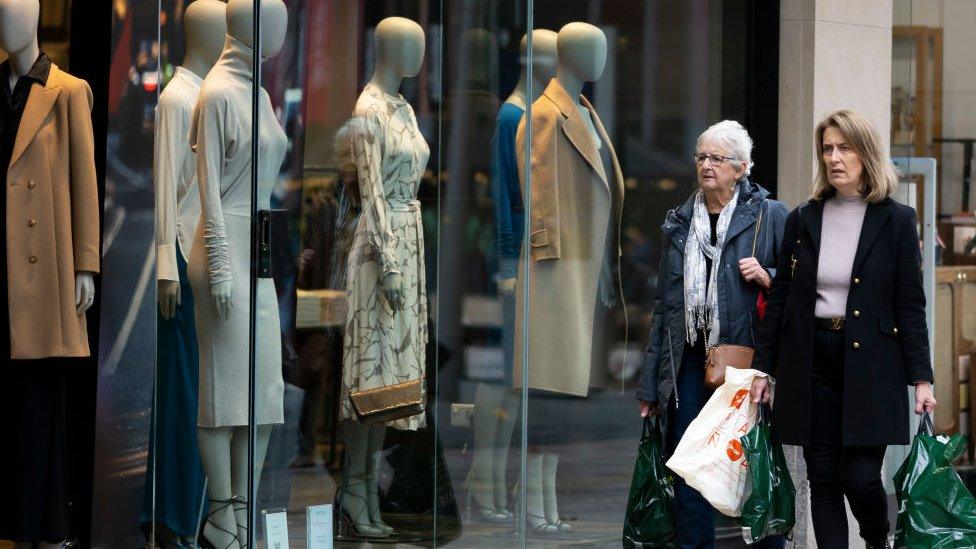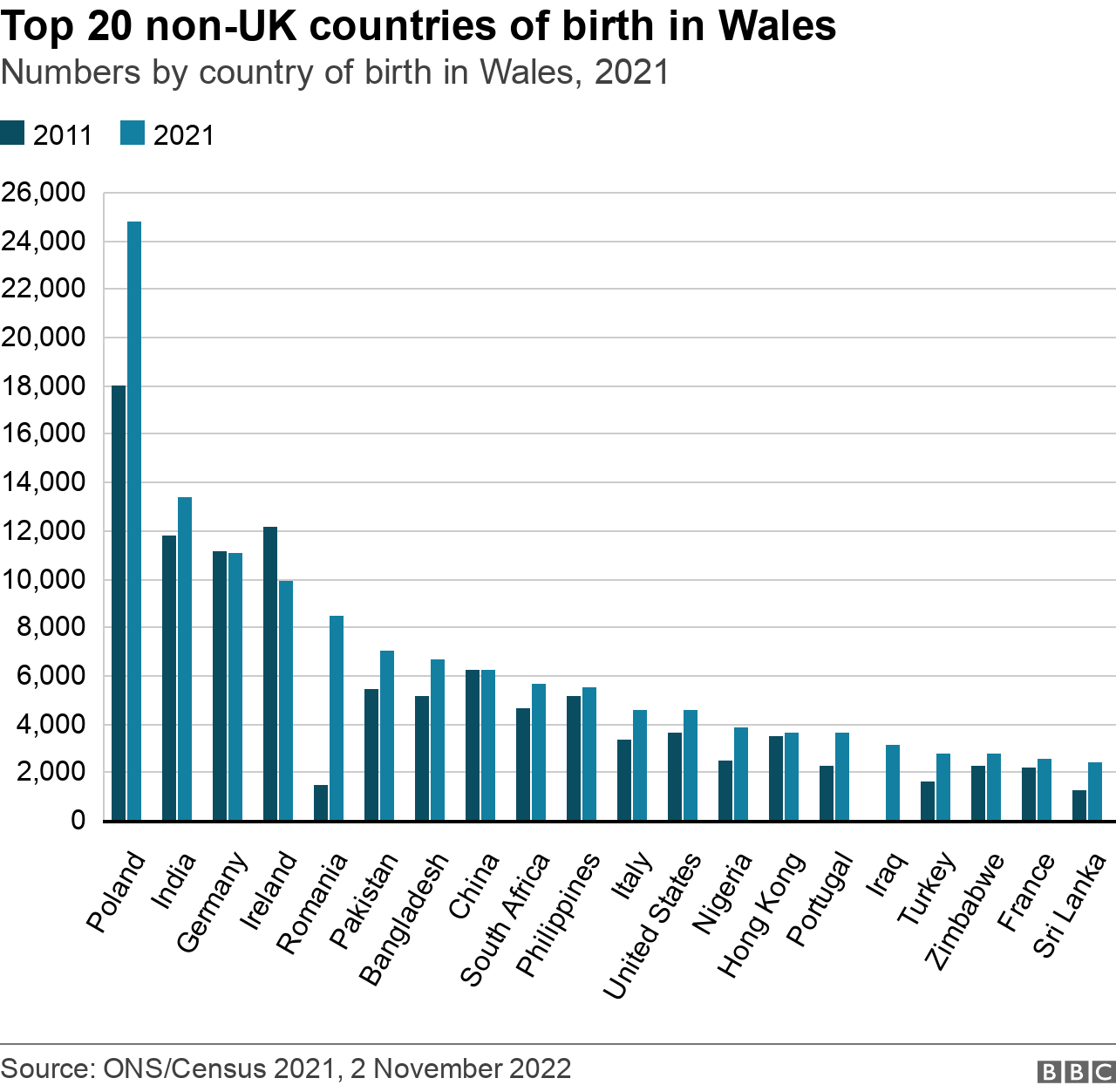Census: Deprivation falls in Wales and rise in foreign-born people
- Published

Cardiff has an average household size of 2.4 people, while it is the youngest county in Wales
Deprivation across Wales has fallen over 10 years, according to latest Census 2021 analysis.
Figures show 54.1% of households were deprived according to one of four indicators used to measure deprivation, which are jobs, education, health or housing.
The figure was 61% in 2011, although Wales remains below England.
Over the same period there were more deaths than births, but net migration increased by around 55,000 people.
Poland is still the most common country of birth outside the UK in Wales.

Wales is less deprived than 10 years ago
The Census looked at four dimensions of deprivation in households - on whether people said they had poor health, their education attainment, housing conditions and also employment status.
Overall, Wales as a whole seems to be less deprived that it was in 2011.
Wales had 54.1% of households deprived in one or more dimension, compared to 61% 10 years ago.
But this is still higher than England (51.6%) and all its regions apart from the north east and West Midlands.
There are now 45.9% of households with no deprivation indicator, compared to 39% in 2011.
16% of Welsh households were deprived in two of the indicators, 4.5% were deprived in three and 0.2% were deprived in all four dimensions.
Blaenau Gwent (61.7%) and Merthyr Tydfil (59.8%) had the highest proportions of households with one deprivation dimension in Wales.
Cardiff, Newport and Merthyr Tydfil (all 0.3%) had the biggest ratio of households with all four deprivation markers.
Cardiff ranks 47th highest of local authorities in England and Wales for numbers of households with all four deprivation indicators.
Broken down into communities, a part of Rhyl has most households - more than 50 - with all four deprivation indicators in Wales. This is followed by three communities in Cardiff - Trowbridge, Adamsdown and St Mellons.
How old are people in Wales?
Wales has a median age of 42, slightly older than 40 in England.
Powys has the highest median age in Wales - 50, followed by Conwy and Monmouthshire (49).
The "youngest" council area is Cardiff, thanks to its large student population, at 34; similarly Newport, which is next lowest with a median age of 38.
29% of people living in Wales were born outside it
The number of residents in Wales who were born outside the UK has increased by 28.3% (48,000) in the 10 years to Census 2021.
This is a little fewer than in England, where the number of residents born outside the UK has risen by 33.6%.
While deaths outnumbered births over this period, it is estimated positive net migration into Wales created around 55,000 additional residents.
The percentage of residents born outside of Wales has risen from 27.3% of the population (837,000) in 2011 to 29.1% (905,000) in 2021, which includes a rise of 23,000 of English-born residents.

Where were people born?
Wales has one of these lowest proportions of people born outside of the UK - 6.9%.
Wales (4.0%) and north east England (3.7%) also had the lowest proportions of the population with non-UK passports.
Newport and Cardiff had seen the biggest rises in Wales in people born outside the UK in the last 10 years - 3.7% and 3.2% increases respectively. The lowest rises were in Pembrokeshire and Powys, while Anglesey had seen a slight reduction.

Cardiff has the highest proportion of people in Wales born outside the UK - 16.5%. This ranks 101st across England and Wales.
It includes 7% of its population born in Asia or the Middle East and 4.7% from across the European Union.
Caerphilly (2.9%) has the lowest proportion in Wales of people born outside the UK - and third lowest across England and Wales - and Anglesey and Blaenau Gwent are also in the lowest 10.
The Census records 16,335 people - 0.5% - had moved from outside the UK to Wales in the previous year, while 8.2% had moved addresses.

Increase in Romanian-born population
In Wales, Poland was still the most common country of birth outside the UK in 2021, with 24,832 people or 0.8% of residents born there.
There was a nearly fivefold increase in the number of people with Romania as a country of birth between 2011 and 2021, rising by 7,025.
Working restrictions for Romanian citizens were lifted in 2014.
Four per cent of the population in Wales (124,557), held a non-UK passport in 2021, the most common of which was Polish.
The number of Irish-born residents in Wales fell by 2,177.
How large are households?
The average household size in Wales is 2.3 residents
Cardiff and Newport (both 2.4 residents per household) had the highest in Wales.
Monmouthshire, Ceredigion and Powys have the highest proportion of two-person households (over 38%) and Newport the most with five or more people (12.8% of all households).
How about marital status?
Of those it applies to, 37% are single or in an non-registered partnership, 43.3% are married, 0.39% - more than 10,000 - are in a same sex marriage or civil partnership.
There are also more than 250,000 divorced people (9.8%) and 7% are widowed.
What is the Census used for?
The details the Census provides are used to help policy-makers and organisations make decisions on how to provide a whole range of services in the future.
The Census has already told us that the population of Wales had risen to record levels. and given us figures on density and some details on age.
Future Census releases in the coming weeks will include updated data on religion, ethnicity and the Welsh language.

FANCY A STROLL?: Welsh walks to try this summer
WILD MOUNTAINS OF SNOWDONIA : Five farming families open their gates and share their lives

Related topics
- Published2 November 2022

- Published28 June 2022

- Published28 June 2022

- Published14 February 2021

- Published12 February 2020
